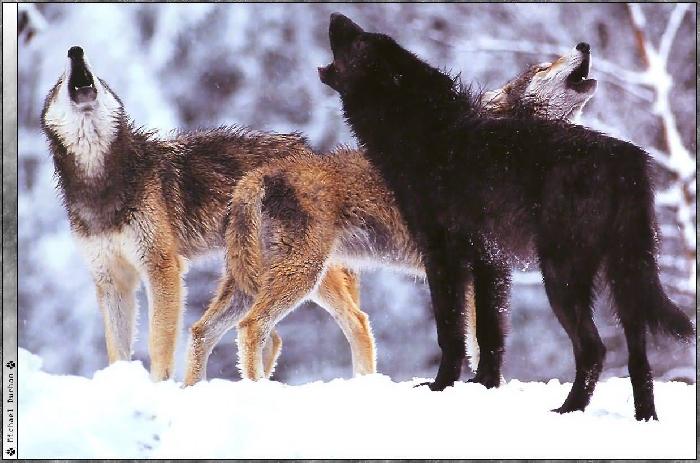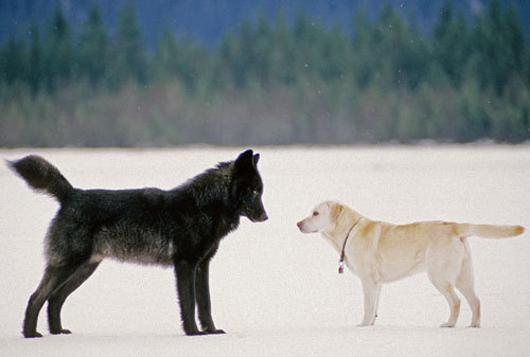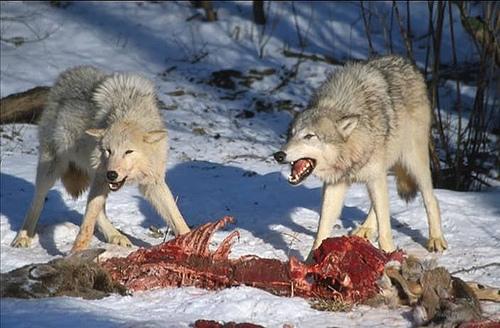Learn About a Dying Species - Facts About Wolves
When man was young on the Earth, millions of wolves roamed world wide. Today, due to centuries of hunting for sport, be it legal or illegal, there are little more than 300,000 wolves left in the world. Wolves are the largest of the canine breed and are often used as the spook in many scary tales.
Diseases Gave Wolves a Taste for Blood
While wolves would pick off a human or two in times of hunger, but they really got their taste for blood in the Middle Ages when the black plague ravaged Europe. With the bodies piling up faster than the healthy could burn and bury, the wolves began to feast on the dead that had been left out.
This happened several times throughout history during outbreaks, such as smallpox, and during world wars where enemy sides occasionally had to team up to fight starving wolves lured to the bloody battlefields. This taste of human flesh could explain why European wolves are so much more aggressive to humans than their North American brothers.
Black Wolves

The black wolves are not a mutation or a natural occurrence within wolves. Black wolves actually stem from interbreeding with dogs. The black fur gene is dominant and passed down through the generations.
You may think white wolves are a similar story, however white fur is genetic to arctic wolves who are some of the toughest wolves on the planet due to their terrain. The white fur is thicker to keep them warm and white to camouflage them in the snow.
Wolves and Dogs

Above I mentioned the relationship between wolves and dogs, how they interbred to create the fiercesome black wolf. Wolves and dogs mating is not a very common occurrence, in fact wolves usually see dogs as a food source.
After World War 2, stray dogs ran rampant in Russia which put them on the food chain for Russian wolves. A singular wolf would usually lure a dog to a secluded place where the rest of the pack would pounce.
Even large breeds of dogs are unable to stand a chance against a wolf, much less a pack of them.
Eating Thier Prey Alive

Wolves, unlike bears and many other predators, lack the tools to bring down large prey even in packs. Wolves prefer animals like deer or moose and usually swarm them as a pack taking bites from their haunches and underbelly until the animal gets tired. While wolves are large and can weigh upwards of 200 pounds, but even a whole pack can not tackle a 600 pound moose.
When the animal falls from having chunks taken out of it, the pack will feast on the animal while it is alive and kicking.
Wolves are the Most Dangerous Rabid Animals
Most animals that contract rabies go through phases of lethargy and disorientation before they reach the rage phase that marks a rabid animal. However, wolves fly almost immediately into a rage, making them extremely dangerous.
Though wolves are not frequent carriers of rabies, they can contract it from the smaller carriers they eat, like raccoons. Rabid wolf attacks on humans have near dropped off the Earth, but they do still occasionally happen. Rabid wolves are most likely to attack a human in the neck or the head, because of this the rabies usually spread to the human brain too quick to be treated.
- The Role Carbs Played In The Evolution Of Dogs
By Linda Cole Scientists are still trying to unravel the mystery behind how wolves evolved into dogs. It happened so long ago, the only evidence scientists have to work with is in archaeological research into how humans evolved and fossilized teeth and...
- New Research Explains Why Dogs Aren't Wolves
By Linda Cole I admire the spirit of wolves, an animal who has found the world to be a hostile place, even though man has embraced a species that was born from them. There are similarities between dogs and wolves, but dogs are not wolves. The reason why...
- Are All Dogs Descendants Of Wolves?
By Linda Cole Through responsible breeding and centuries of domestication, dogs are certainly man's best friend. But how much of their ancestral instincts have dogs maintained even with continued breeding that has calmed ancient instincts? I sometimes...
- The Origin Of The Domesticated Dog
The domestic dog, aka Canis lupus familiaris, originated in the domestication of the gray wolf (Canis lupus). The domestication process continues even today, if we consider the fact that the cross-breeding of dogs in order to create "designer dogs"...
- How To Tell If Your Husband Was Raised By Wolves
Husbands can be wonderful. They can also be a confusing bunch. Husbands make you wonder exactly who raised them and taught them what they know. At first this can be somewhat confusing because you met his family, you've also spent a lot of time with...
